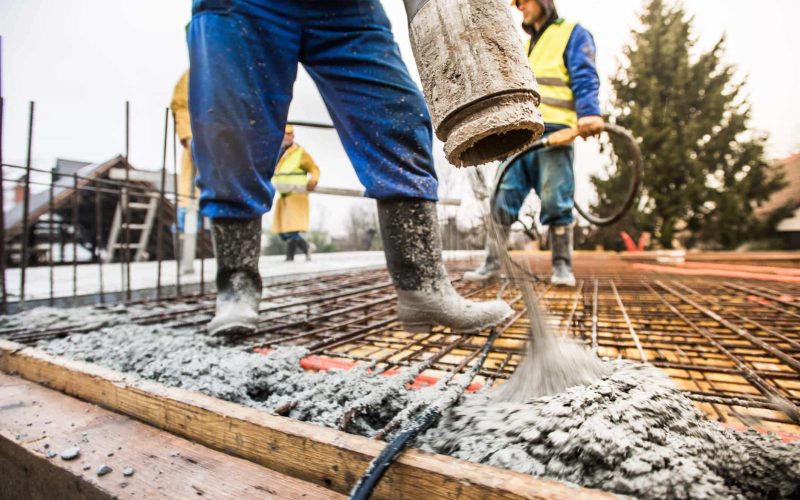You must have heard of concrete and cement because laborers use them in construction projects.
Many people believe they’re the same, but that’s not true. Concrete is a mixture of sand, gravel, water, and cement.
However, cement is just one ingredient in concrete. Cement is a binder that holds everything together.
It binds all the other ingredients together to form a solid mass. Before we discuss the differences between concrete and cement, let’s define them.
What is Concrete?
Concrete combines cement, sand, gravel, water, and coarse aggregate. The exact ratio varies from project to project.
In general, it should be about 40% cement by weight. This means four cement parts to one part of sand, gravel, aggregates, and water.
The concrete mixture can vary depending on what you want your finished product to look like. For example, if you need a smooth surface for a floor or driveway, you will add more sand than gravel.
If you want it to crack and crumble when you walk on it, you’ll add more gravel than sand.
The most common type of concrete used today is Portland cement concrete, which has been around since the late 1800s. Joseph Aspdin, an English engineer at the Royal Society of Arts, invented it.
His invention allowed concrete to be made with less expensive materials. Today, it is still the most popular kind of concrete.
What is Cement?
Cement is a powdery substance composed mainly of calcium oxide and silicon dioxide. When mixed with water, these ingredients of cement react chemically to produce (Ca(OH)2. (Ca(OH)2) hardens into a rock-like material called cement paste.
There are many types of cement, including Portland, high-early strength, low-temperature setting, and rapid-set cement. Each type of cement has its properties, such as how fast it sets and how strong it becomes after curing.
Portland cement is the most popular cement used in a concrete mix. It takes longer to cure than any other type, so it is often used in areas where speed is essential. It is also very durable.
High-early-strength cement is like Portland cement concrete. It sets quickly but does not become as hard as Portland cement concrete.
The strength increases over time. Low-temperature setting cement is designed for outdoor applications.
It cures slowly, allowing structures to be built without waiting for the weather to cool down. It is ideal for building bridges and retaining walls.
Rapid set cement is specially formulated to set in cold temperatures and is commonly used in swimming pools and spas. Rapid-set cement is usually combined with accelerators to speed up the process.
What is the Difference Between Concrete and Cement?
Method of Mixture
When mixing concrete, you have two options: wet and dry. Wet mixes consist of cement, water, and additives, while dry mixes consist of only cement and sand.
A wet mix consists of three main components: cement, sand, and water, with cement being the key ingredient.
These are mixed in a mixer. Different kinds of mixers are available. Some are manual, while others are powered by electricity.
A manual mixer uses a rotating blade inside a tank filled with cement, water, and sand. The blade stirs the contents of the tank, breaking them apart.
An electric mixer uses a motor to rotate blades inside a tank. Electric mixers are generally faster than manual mixers.
A dry mix consists of only one ingredient: cement. It is poured directly onto a form, a method known as direct casting.
Mixing cement is like making bread dough, which hardens through a chemical reaction. You start with flour, yeast, salt, and water.
Then, you combine all these ingredients and knead them until they come together in the cement mixer.
The same thing happens when you make cement. First, add water to the adhesive. Then, you add sand and aggregate.
Finally, add a chemical that helps the cement mix adhere to the sand and aggregate materials.
Uses
Another distinct difference between concrete and cement is their uses. Concrete is beneficial for many things, including roads, sidewalks, driveways, foundations, buildings, and parking lots.
People also use it for decorative purposes. Examples include walkways, patios, and driveways.
The most common type of concrete sealer is epoxy resin. Epoxies can be used by spraying them onto a surface. They harden within minutes and provide a durable finish.
You can use concrete to build fences or decks. If you want something more permanent, you can use concrete pavers. Paver stones are typically made from concrete.
They are laid on top of each other. When they are ready to install, they lift off their forms and place them into position.
Cement is used for everything from building homes to filling cracks in your driveway. It comes in several varieties. For example, low-temperature setting cement is better outdoors.
They cure slowly, so you don’t need to wait for the weather to get cooler before using them. High-temperature setting cement is used indoors and cures fast because it’s heated.
Durability
There are some differences between cement and concrete. Concrete is stronger than cement, but cement lasts longer. We often refer to cement as “the mortar” of construction.
Concrete is much more versatile than cement. It can be used to fill holes, repair walls, and create new structures, while cement is good at holding up heavy objects such as buildings and bridges.
But concrete isn’t just useful for building things. It’s also used to make roads, sidewalks, and driveways. And because concrete is so strong, it’s often used to line swimming pools and patios.
Conclusion
Though concrete and cement are used interchangeably, there are several differences. The listed differences are among the obvious ones, and there are still many more.
Learning and understanding these differences make it easier to know the appropriate one to use at the right time.








